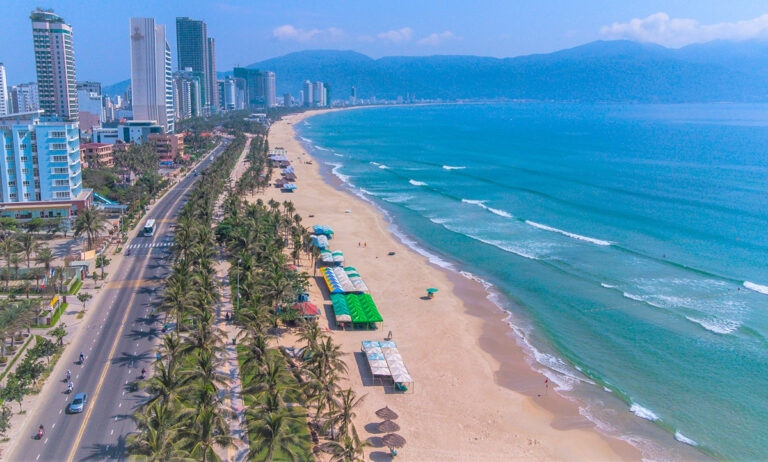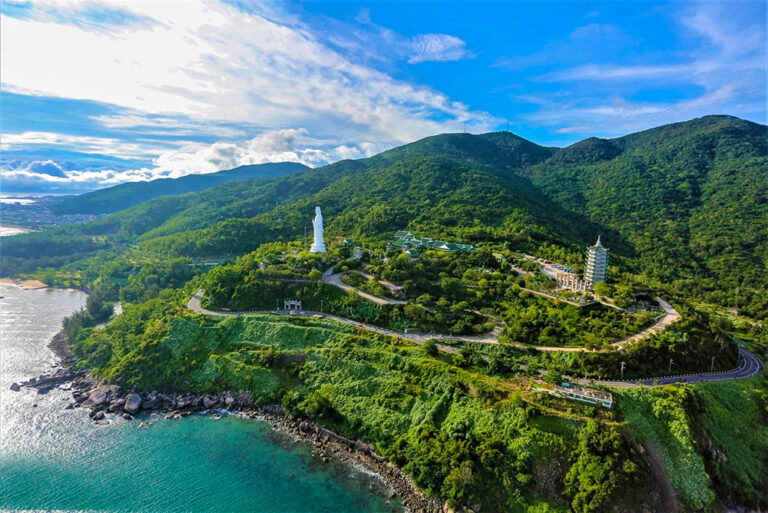Ultimate Guide to the Marble Mountains in Da Nang
In the heart of Da Nang, the Marble Mountains stand majestically as a symbol of nature, history, and spirituality, captivating travelers with their beauty and rich history.
These five limestone hills, named after the five elements of nature – metal, wood, water, fire, and earth – are a must-visit for anyone coming to Da Nang. Not only do they offer panoramic views of the surroundings, but they also house Buddhist sanctuaries, ancient pagodas, and mystical caves, silent witnesses to tumultuous times and stories of resilience.
This site, blending spirituality and history, invites you on a fascinating journey through the legends and realities of Vietnam.
If you have already visited the Marble Mountains, discover 19 other things to do in Da Nang with my article.
The Marble Mountains, what are they?
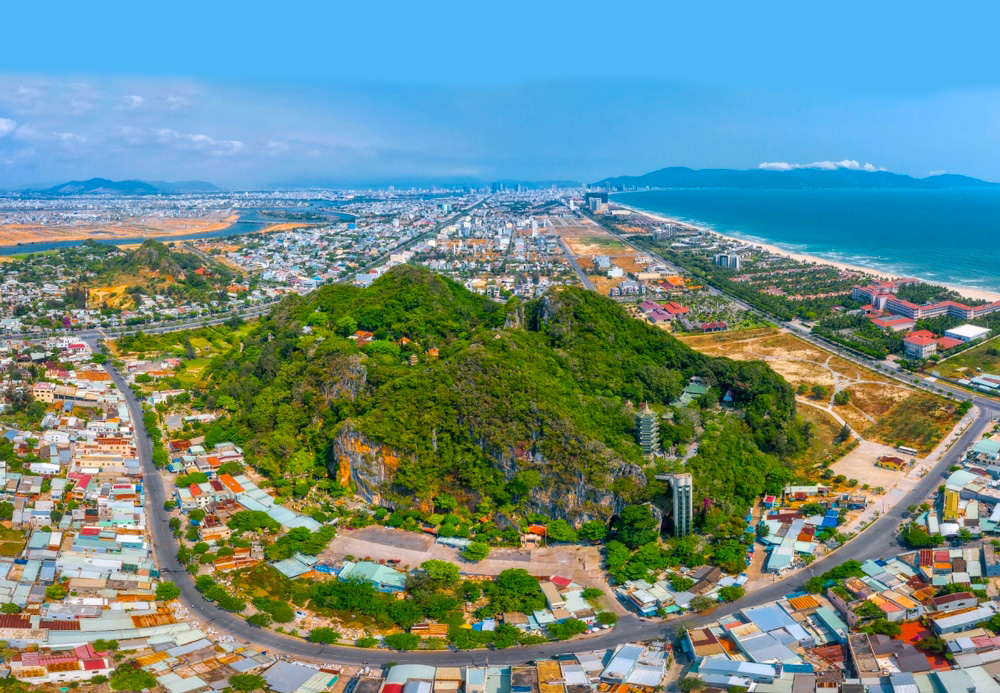
According to a Cham legend, an old fisherman living on the coast of Danang saw a dragon emerge from the water and lay a dragon egg.
When the dragon left, a turtle appeared and claimed to be the god Kim Quy. It was charged by the fisherman to protect the dragon egg. The egg was buried underground. The egg grew until it hatched and then it broke into five pieces.
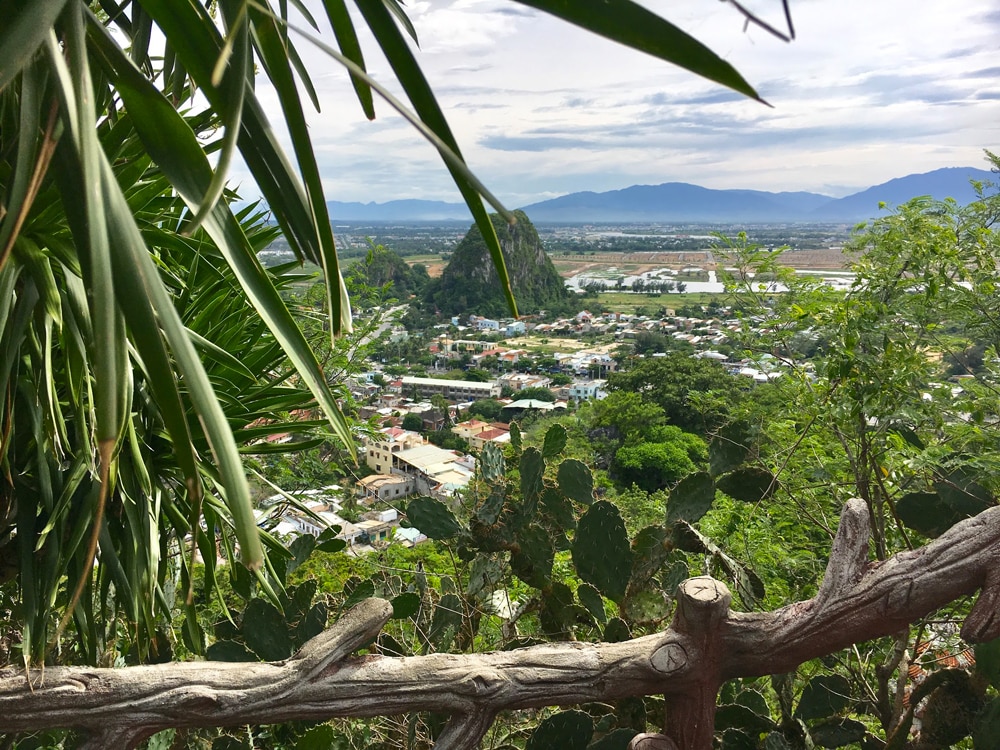
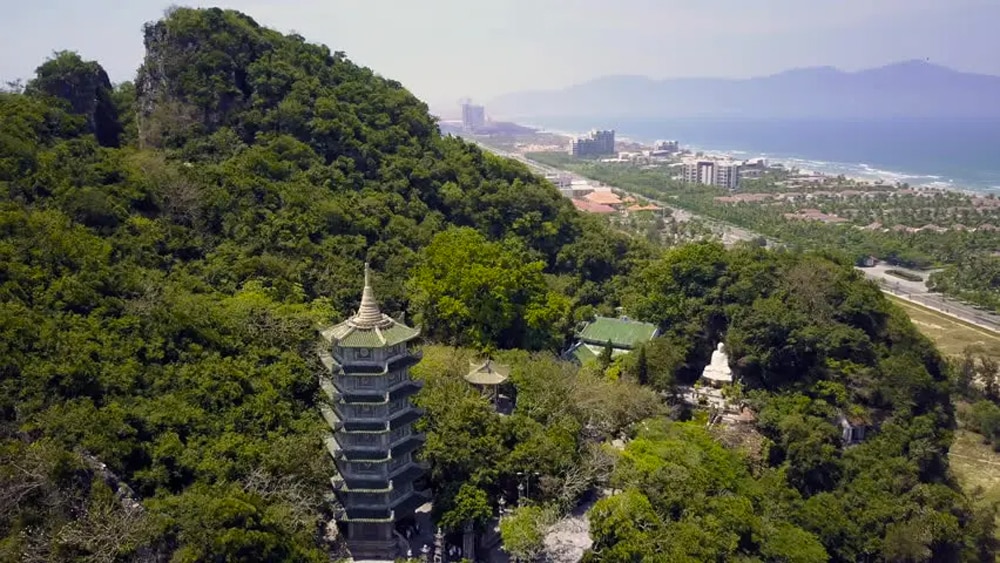
The cluster of limestone outcrops that make up the Marble Mountains were originally sacred sites revered by the Cham people of central and southern Vietnam. However, the mountains are not massive compared to some of the ranges in northern Vietnam.
But they are impressive compared to the plains of the surrounding countryside. It is easy to see why they are attractive to the Cham. They also contain a myriad of cave networks and tunnels that the Cham recognized as holy places.
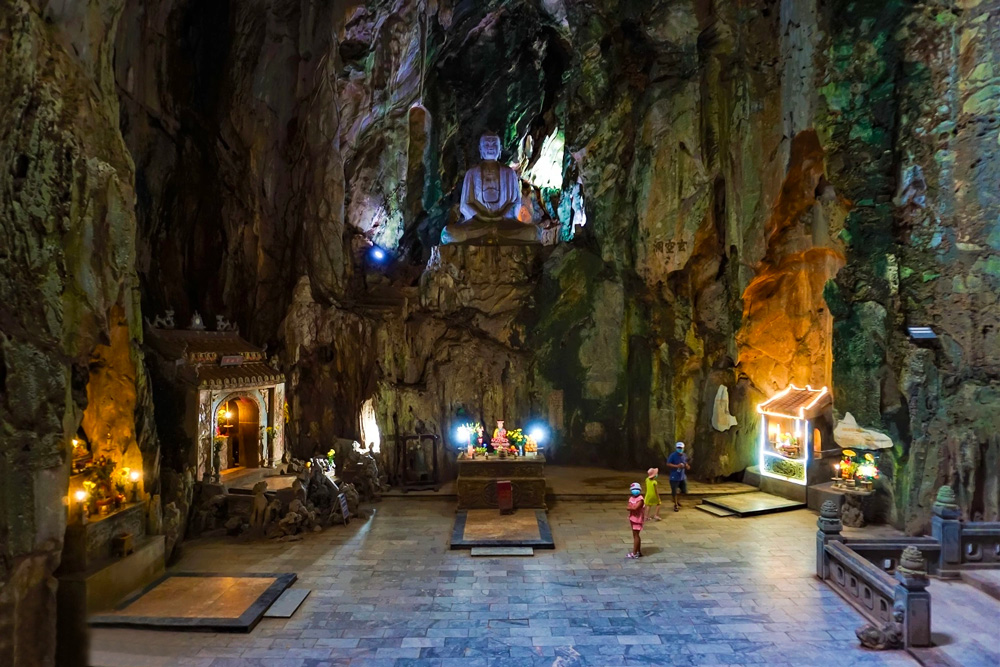
Over the centuries following the Champa empire, Buddhist followers built sanctuaries and temples on top of the mountains and in the caves below. Thus, the Marble Mountains and their sanctuaries inside continue to attract visitors to this day to enjoy their breathtaking views, wander through their complex caves, and be immersed in their history.
In 1825, centuries after the decline of the Cham Empire, the Vietnamese king Minh Mang named the mountains “Ngu Hanh Son” – the mountains of the five elements.
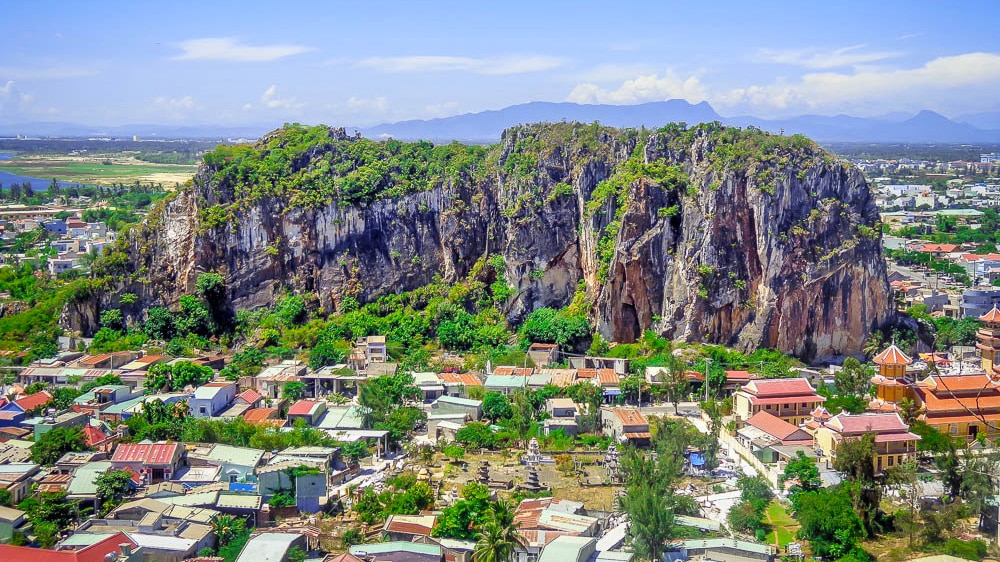
Each mountain is named after one of the five essential elements of Eastern philosophical thought: Kim (metal), Tho (earth), Moc (wood), Hoa (fire), and Thuy (water). Together, the mountains were a spiritual destination both for the Vietnamese aristocracy and Mahayana Buddhists. Thus, over the years, Buddhist followers built the sanctuaries you see today.
Where does the name “Marble Mountains” come from?
During the French colonial period, French geologists realized that the mountains were composed of marble and renamed them “Les Montagnes de Marbre ( Marble Mountains in english )” The French name stuck, and the rest, as they say, is history.
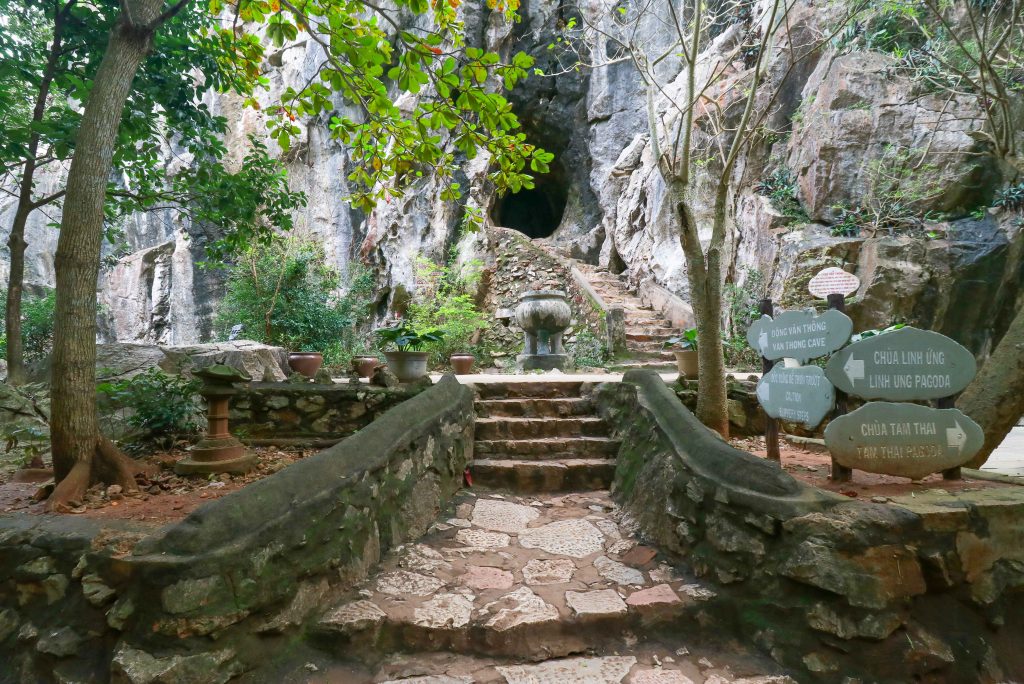
The Marble Mountains During the War
Through a history alternately peaceful and tumultuous, this sacred site served as a refuge for generations of Vietnamese. During the French colonial war, the Huyen Khong cave served as a secret command post for local revolutionaries and an advanced base from which they could organize guerrilla assaults.
However, when the Americans invaded, the government of South Vietnam and the Americans used the cave as a garrison.
In 1968, American forces were attacked and driven out of the Marble Mountains by the People’s Liberation Armed Forces (PLAF, or Viet Cong). Simultaneous assaults on the mountains and nearby U.S. Air Force bases successfully brought the caves back under communist control.
The PLAF then established a secret field hospital in the Huyen Khong cave. Here, they treated wounded guerrillas and spied on nearby American forces at China Beach.
A reminder of this wartime history is a plaque dedicated to the PLAF’s female artillery group hung on the cavern wall. In 1972, the women of this artillery unit destroyed 19 Navy planes stationed at the Marble Mountain Air Facility, an American airfield at the foot of the mountains. It’s an interesting juxtaposition; a testament to military success amid a sacred Buddhist environment.
So as you walk inside the cave, imagine the difficult conditions the Huyen Khong cave offered as a surgery unit.
Thus, it is possible that, despite the dark and challenging conditions, the religious relics looking inward from the cave provided some comfort to the wounded soldiers. Today, the cave has returned to its peaceful origins, attracting thousands of Vietnamese pilgrims each year.
Entrance fees and opening hours for the Marble Mountains
- Entrance by stairs: 40,000 VND per person
- Entrance by elevator: 55,000 VND
- Opening hours: Daily from 7 am to 5:30 pm
- Cave Am Phu entrance fee: 40,000 VND
- Average visit time: 2 hours
- Travel time from Hoi An: 35 to 40 minutes
How to get to the Marble Mountains
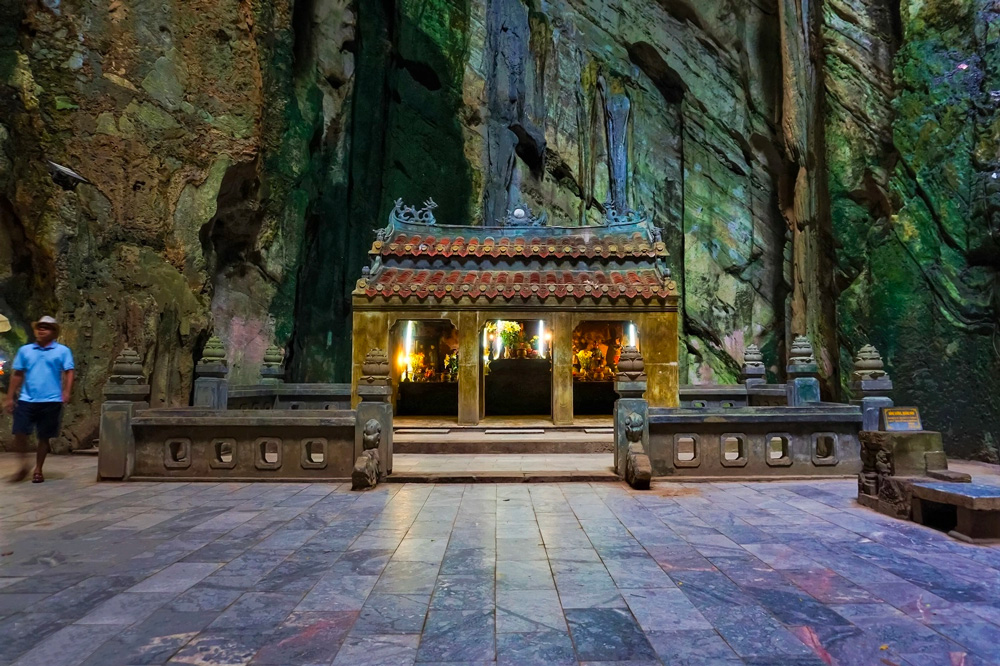
The Marble Mountains are a popular attraction in the area and are not difficult to reach.
- By local bus, count 35,000 VND from Hoi An for a one-way trip, so 70,000 VND round trip. The journey takes about 30 minutes. You just need to take the new bus number 2 that runs between Hoi An and Danang.
- By scooter, count 100,000 VND to 150,000 VND for scooter rental.
- By taxi, it will cost you about 600,000 VND to 650,000 VND for the round trip depending on your bargaining power.
- By private car, it will cost you 550,000 VND in a 4-seater car. I recommend Hoi An Transport Service ( https://hoiantransportservice.com/ )
Visit the Marble Mountains with a English-speaking guide
If you want to visit the Marble Mountains with a English-speaking guide, I recommend the English-speaking agency Hoi An Découverte ( https://hoian-decouverte.com/en/ ) which offers a tour in English or French. It’s always top-notch and the guides from Hoi An Découverte are among the best.
What to see at the Marble Mountains?

The Marble Mountain Thuy Son, which is the largest of the 5 ( 15ha in area and 105m high ) and especially the most interesting since it has several caves and pagodas, some dating from the 17th century.
Little tip: I recommend taking a photo of the map at the entrance when you arrive to make sure you don’t miss anything, and a lamp ( possibly your smartphone’s lamp ) since some caves are quite dark and you might miss some branches that are unfortunately not lit.
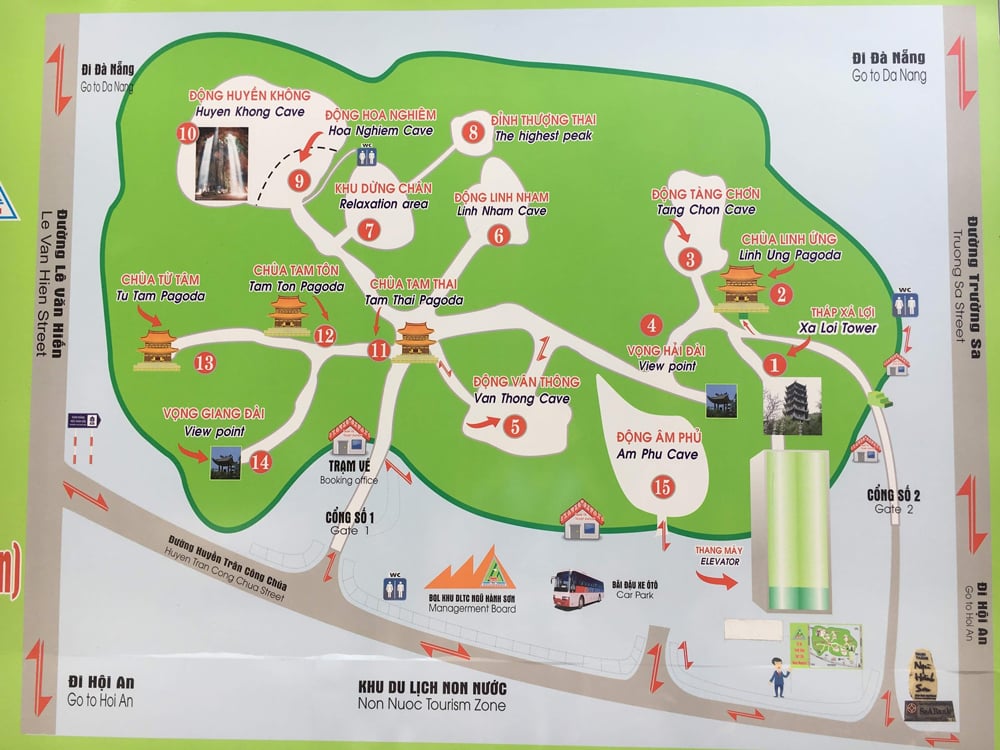
1. Am Phu Cave
The first place to see is the Am Phu Cave ( or Hell Cave ) which is directly accessible without even starting your journey since it is located at the foot of the Marble Mountains.
It is a cave of 302 m with impressive stalactites and stalagmites. Opened in 2006, it is the most surreal and WTF cave you can see in Vietnam but also the most impressive of the Marble Mountains.
The cave is the Buddhist representation of hell and purgatory.
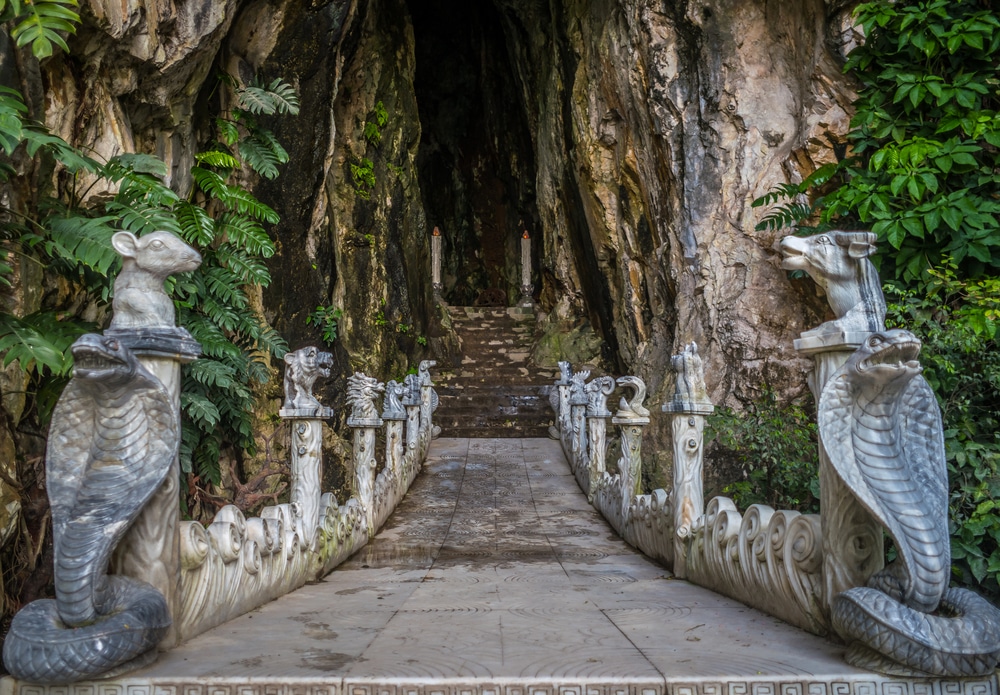
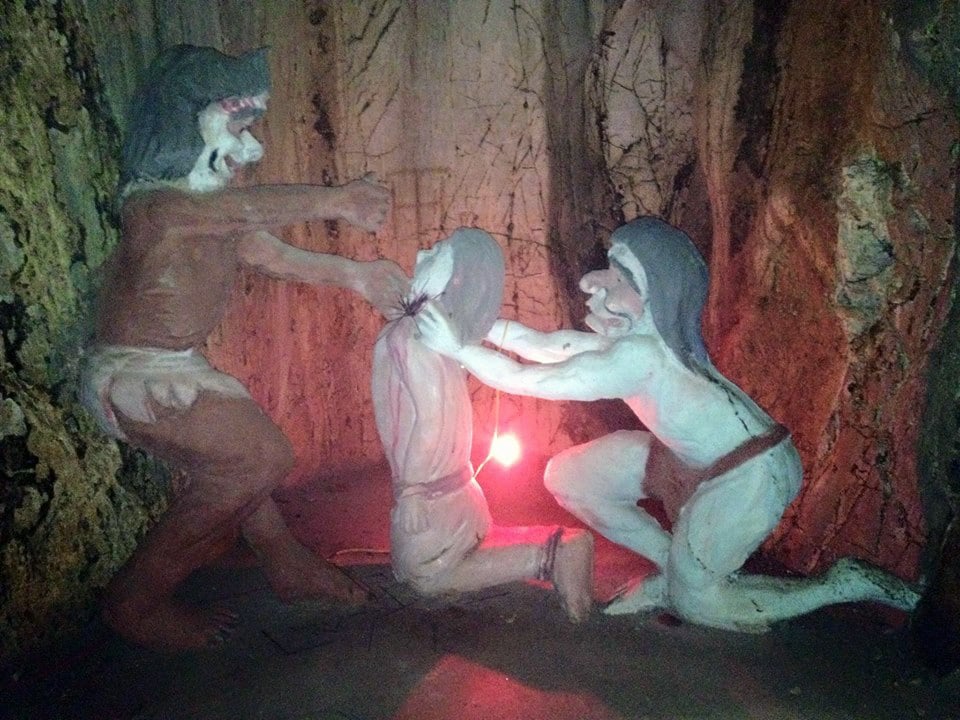
Why WTF you might ask?
Because the statues representing hell and therefore sins are quite improbable. I’ll let you discover them but here is one of the representations above.
The cave is exceptional but is not part of the Marble Mountains entrance ticket. Count 40,000 VND to visit it.
2. Huyen Khong Cave
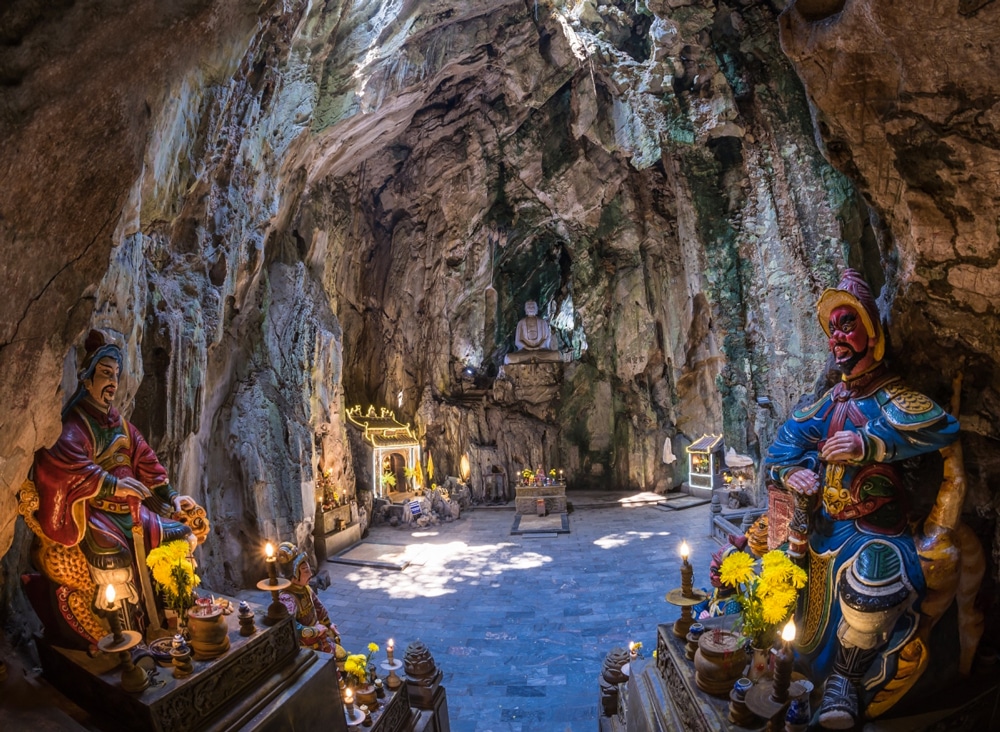
The jewel of the Marble Mountains
This huge cave is the best known and especially the most interesting with Am Phu Cave. It’s a must-see on the site. If you come here without visiting this cave, you haven’t visited the Marble Mountains.
The entrance to this place is guarded by two administrative mandarin statues (to the left of the door) and two military mandarins (to the right).

It has a unique and enchanting atmosphere thanks to an opening at its top that lets in rays of light, which delights photographers.
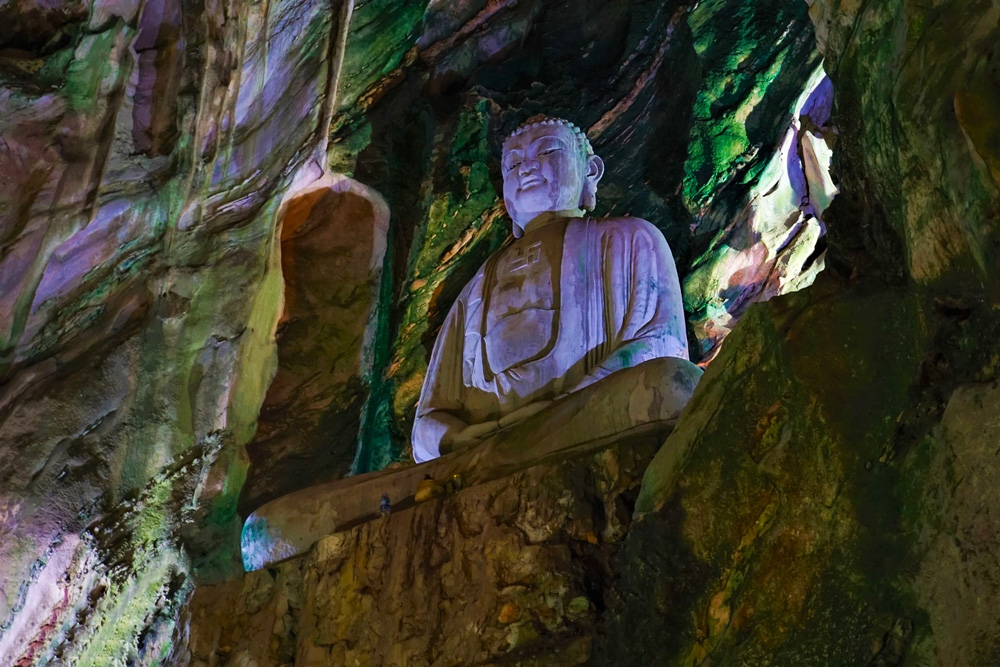
Inside, there are several altars and a small temple. You can also see a large Buddha statue carved into the rock. If you read the beginning of the article, you know it has a historical side since it served as a hospital during the war.
You can’t miss it during your visit.
3. Van Thong Cave
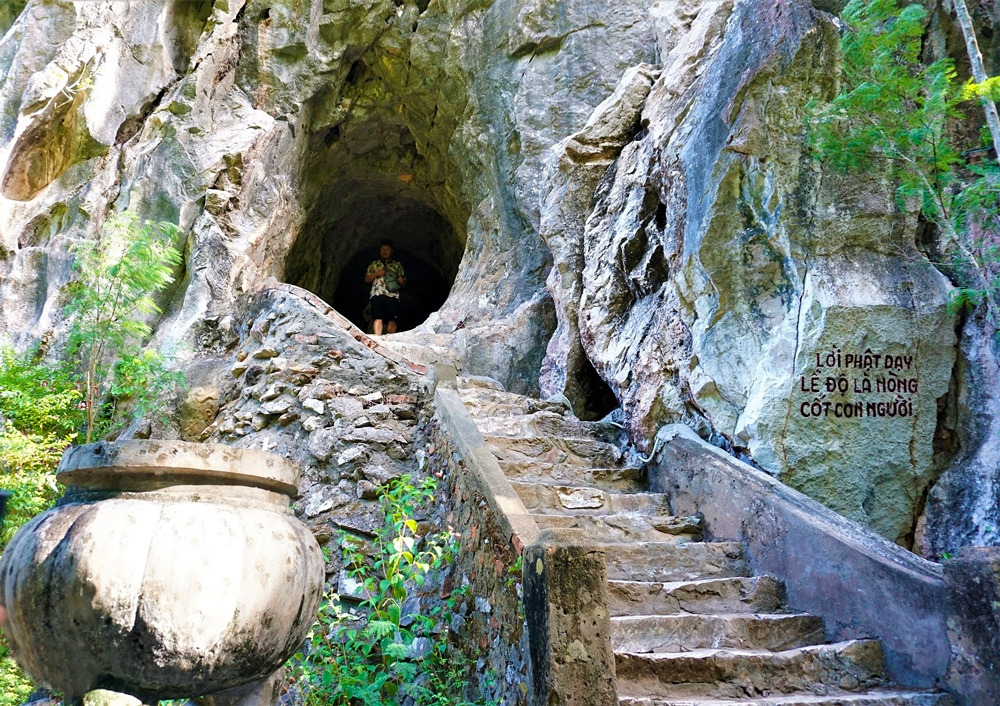
This is a small cave of the Marble Mountains that may seem inconspicuous but has a vertical underground gallery that makes it appealing. It is located behind the statue at the entrance to the cave. By climbing through the gallery, you will reach one of the peaks.
You can descend on the other side by finding your way between the different stones. I climbed through the gallery, it’s not very difficult but I don’t recommend it for children.
You have a view of the surroundings but it’s less impressive than the Highest Peak.
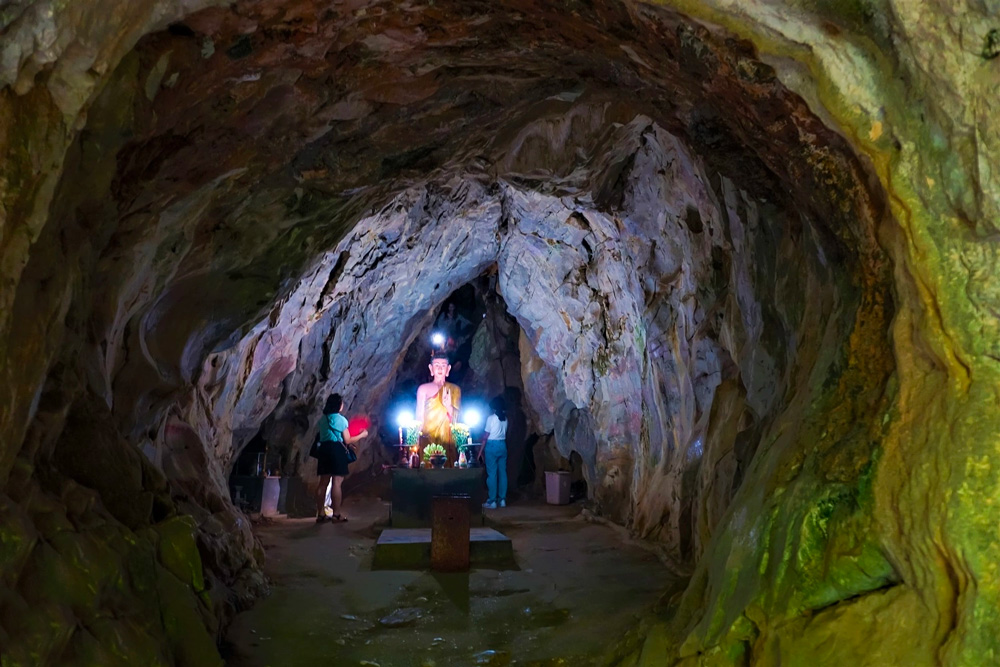

4. Dinh Thuong Thai ( Highest Peak )
Also not to be missed, the Highest Peak which is the highest point of the mountain and offers an unbeatable view of Da Nang. It takes about 250 to 300 steps to reach the summit.
Although the path is quite steep and the stairs seem endless, it’s one of the must-sees of the Marble Mountains with Huyen Khong cave.
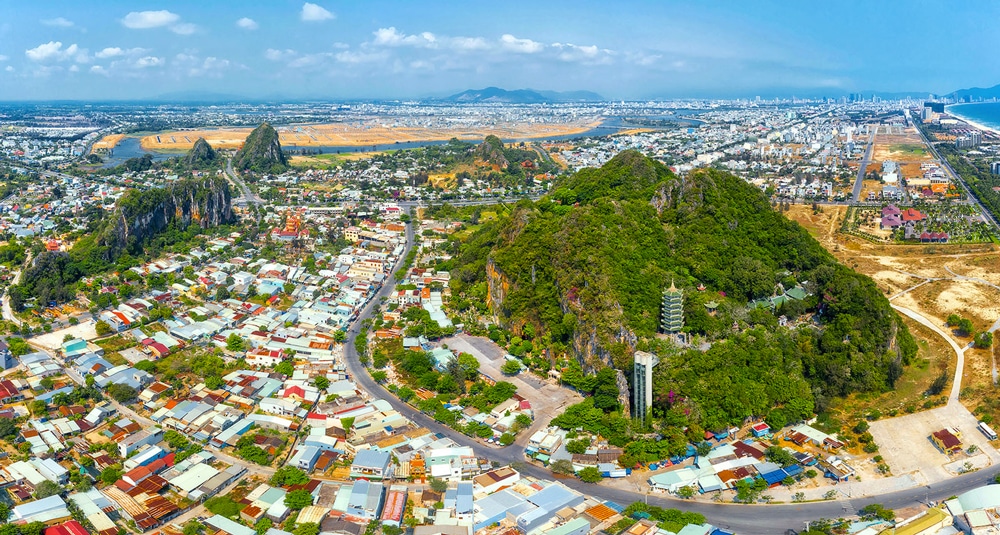
You can take a 360-degree photo at the summit or just admire the view.
5. Tam Thai Pagoda
The Tam Thai Pagoda ( Built in 1630 and rebuilt in 1825 ) is one of the most interesting pagodas of the Marble Mountains. The frescoes of this pagoda represent the story of Buddha.

Don’t forget the Linh Ung Pagoda which dominates the mountain. Inside the main sanctuary, you will find representations of the three Buddhas: A Di Da (Amitabha), the Buddha of the past; Thich Ca Mau Ni (Sakyamuni, or Siddharta Gautama), the Buddha of the Present; and Di Lac (Maitreya), the Buddha of the future.
6. Xa Loi Tower
The Xa Loi Tower, 30m high, comprising 7 floors. Inside the tower, there are nearly 200 Buddhas.
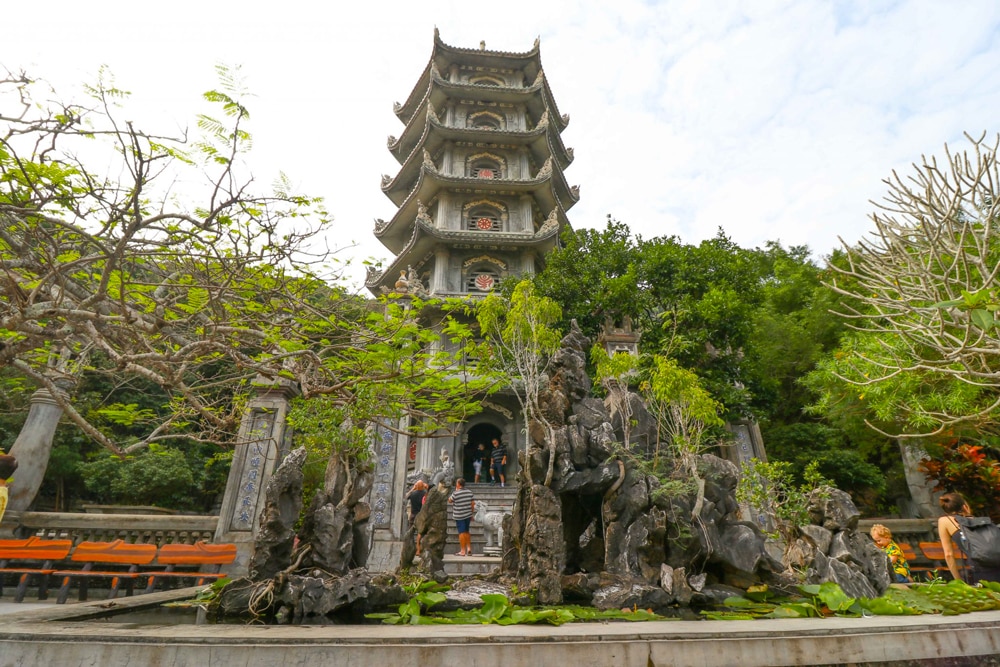
7. Other caves
Tang Chon Cave
Located on the mountain, it’s the first cave you will visit. It has a small temple in the middle. You can admire a Buddha statue at the back of it. It’s nice but nothing special.
Linh Cave
Linh Cave is quite shallow. It’s one of the least interesting. Worth seeing anyway.
My Opinion
If you want to go there, I recommend going either very early or late in the afternoon. It’s one of the must-see monuments in Da Nang, which means it’s touristy, very touristy.
I loved Huyen Khong cave with its history during the war but also it is very photogenic. Am Phu cave is worth its weight in peanuts especially if you take the staircase of hell where you have improbable statues.
Van Thong cave is interesting for its climb to the summit via an underground gallery and the Highest Peak is the Insta spot of the Marble Mountains without hesitation.
Tell me in the comments if you liked it or what you disliked about the Marble Mountains.





